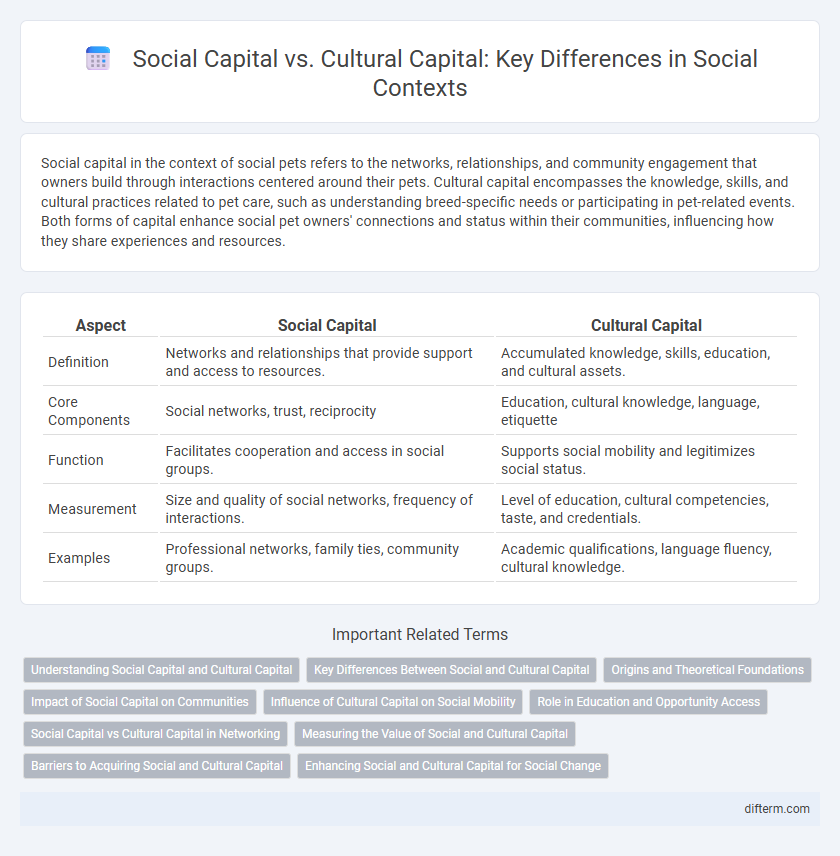Social capital in the context of social pets refers to the networks, relationships, and community engagement that owners build through interactions centered around their pets. Cultural capital encompasses the knowledge, skills, and cultural practices related to pet care, such as understanding breed-specific needs or participating in pet-related events. Both forms of capital enhance social pet owners' connections and status within their communities, influencing how they share experiences and resources.
Table of Comparison
| Aspect | Social Capital | Cultural Capital |
|---|---|---|
| Definition | Networks and relationships that provide support and access to resources. | Accumulated knowledge, skills, education, and cultural assets. |
| Core Components | Social networks, trust, reciprocity | Education, cultural knowledge, language, etiquette |
| Function | Facilitates cooperation and access in social groups. | Supports social mobility and legitimizes social status. |
| Measurement | Size and quality of social networks, frequency of interactions. | Level of education, cultural competencies, taste, and credentials. |
| Examples | Professional networks, family ties, community groups. | Academic qualifications, language fluency, cultural knowledge. |
Understanding Social Capital and Cultural Capital
Social capital refers to the networks, relationships, and norms that enable collective action and trust within a community, facilitating access to resources and support. Cultural capital encompasses the knowledge, skills, education, and cultural competencies that individuals acquire, which influence social mobility and status. Understanding the interplay between social capital and cultural capital is crucial for analyzing how social advantages are maintained and transmitted across generations.
Key Differences Between Social and Cultural Capital
Social capital refers to the networks, relationships, and connections that facilitate cooperation and resource exchange within a community, while cultural capital encompasses knowledge, skills, education, and cultural awareness that enable social mobility. Key differences include social capital's emphasis on social relationships and trust, whereas cultural capital focuses on accumulated cultural knowledge and competencies. Social capital is often leveraged for collective benefits and mutual support, whereas cultural capital primarily influences individual status and access to opportunities.
Origins and Theoretical Foundations
Social capital originates from the works of Pierre Bourdieu and James Coleman, emphasizing the value of social networks and relationships in accessing resources and opportunities. Cultural capital, also conceptualized by Bourdieu, refers to non-financial social assets such as education, intellect, style of speech, and cultural knowledge that influence social mobility and power dynamics. Both forms of capital are foundational to understanding social stratification and the reproduction of inequality within societies.
Impact of Social Capital on Communities
Social capital strengthens communities by fostering trust, cooperation, and shared norms, which enhance collective action and resource exchange. High levels of social capital correlate with improved public health, educational attainment, and economic development, as networks enable individuals to access support and opportunities more effectively. Unlike cultural capital, which centers on knowledge and skills, social capital directly influences communal resilience and social cohesion.
Influence of Cultural Capital on Social Mobility
Cultural capital, including education, language skills, and cultural knowledge, profoundly impacts social mobility by shaping access to social networks and opportunities. Individuals possessing high cultural capital are more likely to navigate social structures effectively, gaining entry to influential groups and enhancing their social capital. This interplay between cultural and social capital facilitates upward mobility by enabling individuals to convert cultural assets into social advantages.
Role in Education and Opportunity Access
Social capital facilitates access to networks, resources, and support systems that enhance educational opportunities and career advancement, while cultural capital encompasses the knowledge, skills, and cultural competencies valued within educational institutions that influence academic success. In education, social capital allows students to leverage relationships for mentorship and information, whereas cultural capital shapes their ability to navigate curriculum expectations and institutional norms. Both forms of capital are critical in determining the accessibility and attainment of educational and professional opportunities, impacting social mobility and inequality.
Social Capital vs Cultural Capital in Networking
Social capital in networking refers to the value derived from relationships, trust, and shared norms that facilitate cooperation and access to resources. Cultural capital encompasses knowledge, skills, education, and cultural competencies that influence social mobility and acceptance within networks. Effective networking relies on leveraging social capital to build connections while utilizing cultural capital to navigate social contexts and enhance credibility.
Measuring the Value of Social and Cultural Capital
Measuring the value of social capital involves assessing networks, trust, and reciprocity within communities that enable collective action and resource exchange. Cultural capital evaluation focuses on the accumulation of knowledge, skills, education, and cultural assets that influence social mobility and status. Quantitative metrics such as social network analysis and qualitative assessments like cultural participation surveys are crucial for capturing the multifaceted impact of both forms of capital on individual and societal development.
Barriers to Acquiring Social and Cultural Capital
Barriers to acquiring social capital often include limited access to influential networks, economic constraints, and social exclusion that restrict interactions with key individuals or groups. Cultural capital acquisition faces obstacles such as unequal educational opportunities, language barriers, and socioeconomic status, which limit exposure to dominant cultural norms and knowledge. These barriers perpetuate social inequality by hindering individuals' ability to leverage social and cultural resources for upward mobility.
Enhancing Social and Cultural Capital for Social Change
Enhancing social capital involves building networks of trust and cooperation that facilitate collective action, while cultural capital encompasses knowledge, skills, education, and cultural awareness that empower individuals within society. Strengthening both forms of capital fosters social change by enabling communities to mobilize resources and navigate social systems more effectively. Programs that integrate cultural education with community-building initiatives promote inclusive development and equitable opportunities for marginalized groups.
social capital vs cultural capital Infographic

 difterm.com
difterm.com